Category Archives: Research
Why covering the environment is one of the most dangerous beats
By Eric Freedman
[This column by the Knight Center director originally appeared in The Conversation]
From the murder of Saudi journalist Jamal Kashoggi by Saudi agents to President Trump’s clashes with the White House press corps, attacks on reporters are in the news. This problem extends far beyond the politics beat, and world leaders aren’t the only threats.
At Michigan State University’s Knight Center for Environmental Journalism, we train students and professional journalists to report on what we view as the world’s most important beat. One hard fact is that those who cover it are at heightened risk of murder, arrest, assault, threats, self-exile, lawsuits and harassment.
In a recent study, I explored this problem through in-depth interviews with journalists on five continents, including impacts on their mental health and careers. I found that some of them were driven away from journalism by these experiences, while others became even more committed to their missions.
In the cross-hairs
Covering the environment is one of the most hazardous beats in journalism. According to one estimate, 40 reporters around the world died between 2005 and September 2016 because of their environmental reporting – more than were killed covering the U.S. war in Afghanistan.
Environmental controversies often involve influential business and economic interests, political battles, criminal activities, anti-government insurgents or corruption. Other factors include ambiguous distinctions between “journalist” and “activist” in many countries, as well as struggles over indigenous rights to land and natural resources.
In both wealthy and developing countries, journalists covering these issues find themselves in the cross-hairs. Most survive, but many undergo severe trauma, with profound effects on their careers.
As one example, in 2013 Rodney Sieh, an independent journalist in Liberia, disclosed a former agriculture minister’s involvement in a corrupt scheme that misused funds earmarked to fight the parasitic, infectious Guinea worm disease. Sieh was sentenced to 5,000 years in prison and fined US$1.6 million for defamation. He served three months in Liberia’s most notorious prison before an international outcry pressured the government into releasing him.
In the same year, Canadian reporter Miles Howe was assigned to cover protests by the Elsipotog First Nation in New Brunswick against hydraulic fracturing for natural gas. Howe worked for an independent online news organization that sought to spotlight unreported and under-reported stories.
“Many times I was the only accredited journalist witnessing rather violent arrests, third-trimester pregnant women being locked up, guys tackled to the ground,” he recalls. Howe was arrested multiple times, and during one protest a member of the Royal Canadian Mounted Police pointed him out and shouted, “He’s with them!” His equipment was seized, and police searched his home. They also offered to pay him for providing information about upcoming “events” – in other words, spying on the protesters.
Psychological impacts
The relatively few studies that have examined attacks on reporters show that such treatment can have lingering impacts, including post-traumatic stress disorder and depressive and substance use disorders. While some journalists are able to cope and recover, others live in a state of fear of future incidents, or suffer survivor guilt if they escape and leave relatives and colleagues behind.
“Overall, journalists are a pretty resilient tribe,” Bruce Shapiro, executive director of the Dart Center for Journalism and Trauma at Columbia University, told me. “Their rates of PTSD and depression are about 13 to 15 percent, which is comparable to rates among first responders. Environmental or social justice reporters often have a higher-than-average sense of mission and purpose and a higher level of skill,” beyond that of some of their peers on other beats.
But this attitude can translate into reluctance to seek help. Most journalists I interviewed didn’t seek therapy, usually because no services were available or because of the profession’s machismo factor. Gowri Ananthan, a lecturer at the Institute of Mental Health in Sri Lanka, calls journalism “a profession in denial,” even as some victims acknowledge the price they’ve paid.
For example, Miles Howe suffered serious psychological problems following his arrests. “What did it do to me? It made me upset, angry,” he says. Howe didn’t seek therapy until he left journalism more than two years later, but in hindsight regrets not acting sooner.
Others told me their experiences recommitted them to their missions as journalists. Rodney Sieh says his stint in prison “really elevated our work to an international level that we would never have had if I weren’t arrested. It made us stronger, bigger, better.”

Indigenous rights versus professional ethics
Environmental controversies often involve indigenous rights. In South America, for example, indigenous journalists and “ethno-communicators” are playing an increasingly vital role in uncovering vast exploitation of natural resources, forests and land.
Despite professional codes calling for balanced, impartial coverage, some reporters can feel compelled to take sides on these stories. “We saw that clearly at Standing Rock,” says Tristan Ahtone, a board member of the Native American Journalists Association, referring to protests on the Standing Rock Indian Reservation in North Dakota against the Dakota Access Pipeline.
“NAJA had to put out ethical guidelines for journalists. We saw it mostly with young Native reporters who were happy to blow the ethical line,” Ahtone says. “A lot of it is having a different world view.”
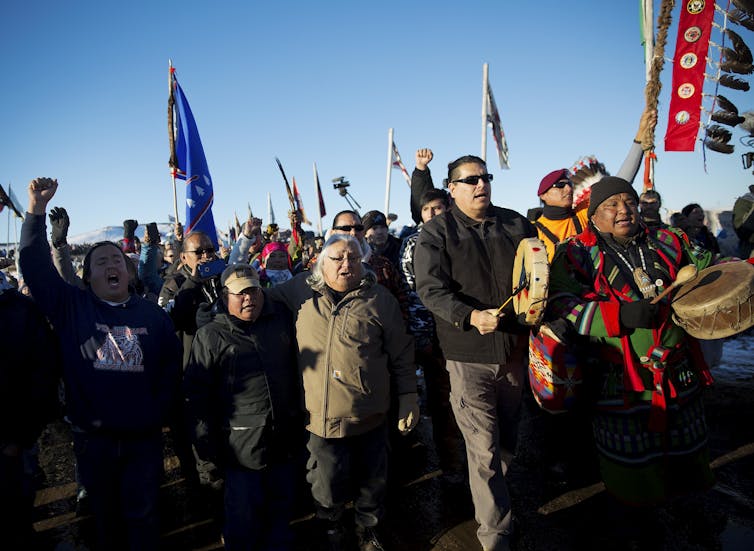
Better training and legal protection
Many of these issues need further research. From a craft perspective, how do these experiences affect journalists’ approach to reporting? How do they deal with sources afterwards, especially if those people are also at risk? How do editors and news directors subsequently treat reporters in terms of assignments, story placement and salaries?
These findings also raise questions about how press rights groups can successfully protect and advocate for environmental reporters. In my view, more environmental journalists need the type of safety training that many war and foreign correspondents now receive.
Pollution and natural resource damage affect everyone, especially the poorest and most vulnerable members of society. The fact that journalists who report on these issues are so vulnerable is deeply disturbing. And their abusers often operate with impunity.
For example, there have been no convictions in the 2017 murder of Colombian radio journalist Efigenia Vásquez Astudillo, who was shot while covering an indigenous movement to take back ancestral land that had been converted to farms, resorts and sugar plantations. As the Committee to Protect Journalists observes, “Murder is the ultimate form of censorship.”
Of Fortresses and Fortitude
Story and Photos By Eric Freedman

Narikala Fortress
Georgia is an ancient mountainous country settled thousands of years ago. Some of the most dramatic evidence of its past are what’s left of the fortresses, castles and stone walls build to protect the country from invading armies of Romans, Russians, Persians, Arabs, Turks and other peoples seeking to conquer Georgia – and who often succeeded.
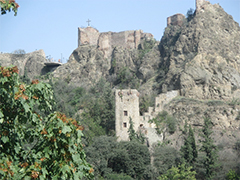
Remains Narikala Fortress
Above the Old Town section of Tbilisi you can visit the remains of Narikala Fortress. The original fort overlooking the Kura River was built about 1,700 years ago, restored in the 1500s and ruined in an 1827 earthquake. Much of the fortress has crumbled, but some walls still stand. The fortress is illuminated at night and glows with yellowish-brown colors – I can see it from my 8th-floor apartment window a few miles away.
The picture above shows part of the remains of Narikala Fortress as seen from the National Botanic Garden of Georgia.
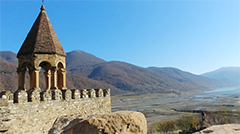
Watchtower Ananuri
Ananuri was once a castle and seat of the feudal dukes of Aragvi. Their watchtower and church complex stands tall partly intact, partly in ruins. What was it like to be on guard duty in places like these isolated outposts, lonely outposts, on bitterly cold nights with the security of a kingdom riding on your ability to spot and defeat relentless enemies?
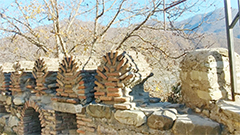
Ananuri castle
It’s not only forts that stand high for protection in Georgia. So do Orthodox churches and monasteries that provided physical as well as spiritual protection. One is the 6th-7th century Jvari Church looming above the country’s one-time capital of Mtskheta.
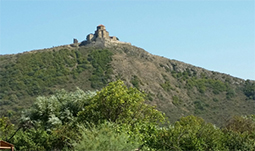
Gergeti Trinity Church
It was on this site that, we are taught, Saint Nino – who is credited with converting Georgia to Christianity – erected a cross overlooking shrines to the pagan gods.
Similarly, the 14th century Gergeti Trinity Church looks tiny from the town of Stepanstminda far below, while Stepanstminda and the Georgian Military Highway heading north to Russia look tiny from the church grounds far above.
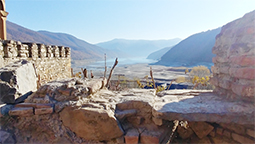
Sentry spot Gergeti Trinity Church
Worshippers lit candles during my visit but it’s easy to envision sentries on duty here amidst snow-capped mountains and fierce winter winds.
Even older are the ancient remains of the cave city of Uplistsikhe, about an hour’s drive from Tbilisi. Here you can wander through centuries-old ruins. Life must have been harsh here – no running water, no bathrooms, no internet, no fast food, no malls.
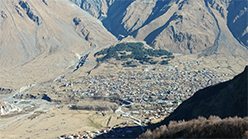
Looking down on the town from Gergeti Trinity Church
This site once hosted temples dedicated to the sun goddess and served as a trading center for merchants and caravans traveling along the Silk Road that connected Europe with Central Asia and China. The paths are steep and sometimes slippery, but at the top are scenic views of the valley below.
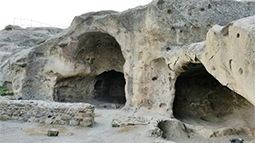
Caves of Uplistskihe
And the view from there:
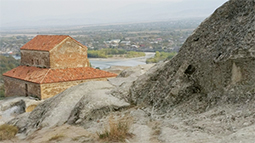
View from caves
Knight Center director lectures about economic costs of pollution
Many people think of science as precise, as exact. After all, those scientists are using computers and satellites and expensive laboratories to answer important questions so they must always get the correct answers, right? There’s also a lot of math in science that makes their answers even more precise, right?
Not true. There are many, many uncertainties in science. When you add in the human factor and economics, the answers become even more uncertain.
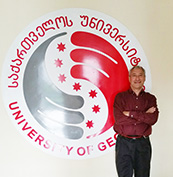
Eric Freedman
So when Knight Center director Eric Freedman was invited to talk to a journalism class at the University of Georgia in Tbilisi (Republic of Georgia) about the economic costs of pollution, especially health and social costs, he turned first to a comprehensive October 2017 report by the Lancet Commission on Pollution and Health. Investigative environmental journalist Tsira Gvasalia teaches the environmental health reporting course.
While it’s impossible to put a precise price tag on the problem, we can summarize the study by saying that outdoor and indoor air pollution, water and soil contamination, and chemical pollutants cause millions of people to die early each year at a cost of trillions of dollars. Continue reading
